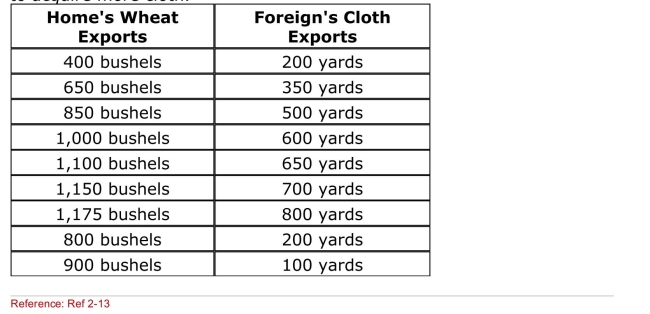Multiple Choice
SCENARIO: HOME'S WILLINGNESS TO TRADE WHEAT FOR CLOTH
Home has a comparative advantage in wheat, and Foreign has a
Comparative advantage in cloth.Once trade occurs, Home produces
1,500 bushels of wheat, and Foreign produces 1,000 yards of cloth.The
Following table shows the amount of wheat that Home is willing to trade
To acquire more cloth. 
(Scenario: Home's Willingness to Trade Wheat for Cloth) Suppose that
Home's export price rose from 0.5 bushel of wheat per yard of cloth in
2009 to a bushel of wheat per yard of cloth in 2010.We conclude that
The change in Home's export price means that Home was worse off in
2010 than it was in 2009.Which of the following statements best
Explains this conclusion?
A) Home had to export twice as much wheat to obtain a yard of cloth in 2010 as it did in 2009.
B) Home had to export half as much wheat to obtain a yard of cloth in 2010 as it did in 2009.
C) Home had to export the same amount of wheat to obtain a yard of cloth in both 2009 and 2010.
D) Home had to export three times the amount of wheat to obtain a yard of cloth in 2010 as it did in 2009.
Correct Answer:

Verified
Correct Answer:
Verified
Q4: What does the term <i>value-added per hour
Q66: To complete the model of international trade
Q67: The Ricardian model can be simplified and
Q68: It is possible to determine how much
Q69: Figure: Upperia's Production and Consumption <img src="https://d2lvgg3v3hfg70.cloudfront.net/TB7261/.jpg"
Q72: According to the Ricardian principle of comparative
Q89: David Ricardo believed that:<br>A) trade is a
Q94: The increase in total utility derived from
Q119: Using the marginal product theory of wages,
Q121: What is the marginal product of labor?<br>A)